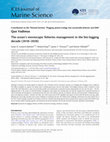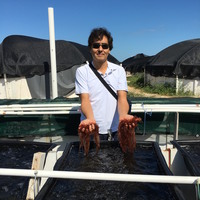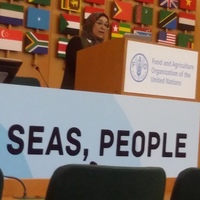Papers by Susan Lowerre-Barbieri

Spatial and temporal patterns of spawning activity are important measures of resilience in fishes... more Spatial and temporal patterns of spawning activity are important measures of resilience in fishes that directly link environmental disturbances with reproductive success. We acoustically monitored spawning in spotted seatrout (<i>Cynoscion nebulosus</i>) from April through September 2017 at 15 sites near Port Aransas, Texas, that coincided with the landfall of a category 4 hurricane (Harvey) on 25 August. Spawning sounds were recorded every day of the study across all sites and were also confirmed during the hurricane at two sites located within the eye of the storm. Daily spawning continued after the hurricane, but the onset of spawning shifted 2.12 h earlier for 5 days, after which it returned to the pre-storm schedule. These results illustrate the resilience of seatrout to intense, episodic disturbances and offer insights on the phenotypic plasticity of estuarine fishes to cope with projected increases in environmental variability.

Biology Letters, Nov 1, 2018
Spatial and temporal patterns of spawning activity are important measures of resilience in fishes... more Spatial and temporal patterns of spawning activity are important measures of resilience in fishes that directly link environmental disturbances with reproductive success. We acoustically monitored spawning in spotted seatrout (Cynoscion nebulosus) from April through September 2017 at 15 sites near Port Aransas, Texas, which coincided with the landfall of a category 4 hurricane (Harvey) on 25 August. Spawning sounds were recorded every day of the study across all sites and were also confirmed during the hurricane at two sites located within the eye of the storm. Daily spawning continued after the hurricane, but the onset of spawning shifted 2.12 h earlier for 5 days, after which it returned to the pre-storm schedule. These results illustrate the resilience of seatrout to intense, episodic disturbances and offer insights on the phenotypic plasticity of estuarine fishes to cope with projected increases in environmental variability.

Canadian Journal of Fisheries and Aquatic Sciences
Efforts to manage small and medium-sized pelagic fishes (SMPF) using traditional stock assessment... more Efforts to manage small and medium-sized pelagic fishes (SMPF) using traditional stock assessment methods are hampered by the elusive relationship between spawning stock biomass and recruitment. We propose to compute a reproductive resilience index (RRI) in three steps: ( i) we selected 16 biological traits related to distinct aspects of SMPF reproductive biology and characterized by a continuous (e.g., growth rate) or ordinal variable (e.g., spawning site fidelity) scored from 1 to 5 (1 representing a low contribution of the trait to reproductive resilience); ( ii) an expert panel assigned the traits’ scores to five exploited species in the southern Humboldt Current Large Marine Ecosystem; ( iii) a Bayesian Belief Network (BBN) model was used to estimate an RRI based on the combination of the traits’ scores. The BBN was used to explore environmental effects on the species’ RRI, as some reproductive traits can show intraspecies variability under external forces (e.g., fishing pressu...
Supplementary material for the manuscript entitled "A reproductive resilience index for pela... more Supplementary material for the manuscript entitled "A reproductive resilience index for pelagic fish in the southern Humboldt Current Large Marine Ecosystem" by: Andres Ospina-Alvarez, Sebastián I. Vásquez, Ignacio A. Catalán, Susan Lowerre-Barbieri, Marcos Arteaga & Silvia de Juan.
Raw data associated with recordings of sound production in the Spotted Seatrout (<i>Cynosci... more Raw data associated with recordings of sound production in the Spotted Seatrout (<i>Cynoscion othonopterus</i>) at 15 sites within the Mission-Aransas National Estuarine Research Reserve near Port Aransas, Texas, USA, from April through September 2017. Data managed by Brad Erisman from the University of Texas at Austin. The results associated with these data are found in Biggs et al. (2018; Reproductive resilience of an estuarine fish in the eye of a hurricane; Biology Letters).
Mean back-calculated weakfish total lengths (mm) at age based on scales and otoliths, calculated ... more Mean back-calculated weakfish total lengths (mm) at age based on scales and otoliths, calculated from a quadratic body to hardpart regression and observed mean total length at time of annulus formation 39 Mean scale annular radii (SAR), for each scale age of weakfish.
Gulf and Caribbean Research, 2018

ICES Journal of Marine Science, 2018
Although movement has always played an important role in fisheries science, movement patterns are... more Although movement has always played an important role in fisheries science, movement patterns are changing with changing ocean conditions. This affects availability to capture, the spatial scale of needed governance, and our food supply. Technological advances make it possible to track marine fish (and fishermen) in ways not previously possible and tracking data is expected to grow exponentially over the next ten years-the biologging decade. In this article, we identify fisheries management data needs that tracking data can help fill, ranging from: improved estimates of natural mortality and abundance to providing the basis for short-term fisheries closures (i.e. dynamic closures) and conservation of biodiversity hotspots and migratory corridors. However, the sheer size of the oceans, lack of GPS capability, and aspects of marine fish life history traits (e.g., adult/ offspring size ratios, high mortality rates) create challenges to obtaining this data. We address these challenges and forecast how they will be met in the next 10 years through increased use of drones and sensor networks, decreasing tag size with increased sensor capacity trends, the ICARUS initiative to increase satellite tracking capacity, and improved connectivity between marine and terrestrial movement researchers and databases.

PloS one, 2017
Managed reef fish in the Atlantic Ocean of the southeastern United States (SEUS) support a multi-... more Managed reef fish in the Atlantic Ocean of the southeastern United States (SEUS) support a multi-billion dollar industry. There is a broad interest in locating and protecting spawning fish from harvest, to enhance productivity and reduce the potential for overfishing. We assessed spatiotemporal cues for spawning for six species from four reef fish families, using data on individual spawning condition collected by over three decades of regional fishery-independent reef fish surveys, combined with a series of predictors derived from bathymetric features. We quantified the size of spawning areas used by reef fish across many years and identified several multispecies spawning locations. We quantitatively identified cues for peak spawning and generated predictive maps for Gray Triggerfish (Balistes capriscus), White Grunt (Haemulon plumierii), Red Snapper (Lutjanus campechanus), Vermilion Snapper (Rhomboplites aurorubens), Black Sea Bass (Centropristis striata), and Scamp (Mycteroperca p...

Ecological Applications, 2017
This paper reviews the use of acoustic telemetry as a tool for addressing issues in fisheries man... more This paper reviews the use of acoustic telemetry as a tool for addressing issues in fisheries management, and serves as the lead to the special Feature Issue of Ecological Applications titled Acoustic Telemetry and Fisheries Management. Specifically, we provide an overview of the ways in which acoustic telemetry can be used to inform issues central to the ecology, conservation, and management of exploited and/or imperiled fish species. Despite great strides in this area in recent years, there are comparatively few examples where data have been applied directly to influence fisheries management and policy. We review the literature on this issue, identify the strengths and weaknesses of work done to date, and highlight knowledge gaps and difficulties in applying empirical fish telemetry studies to fisheries policy and practice. We then highlight the key areas of management and policy addressed, as well as the challenges that needed to be overcome to do this. We conclude with a set of ...

Marine and Coastal Fisheries, 2011
Although incorporating detailed reproductive data into all stock assessments is not a practical g... more Although incorporating detailed reproductive data into all stock assessments is not a practical goal, the need to understand how reproductive biology affects population productivity is being increasingly recognized. More research focused on reproductive biology—coupled with a shift towards a resilience perspective in fisheries science—is resulting in challenges to many long‐held assumptions; the emergence of important new issues; and identification of the need to improve data and methods used in reproductive studies. Typically, data for reproductive studies are based on an assessment of gonadal development, which is most accurately evaluated with histology. This special section of Marine and Coastal Fisheries contains contributions from a workshop on the gonadal histology of fishes that was held in Cadiz, Spain, during June 2009. These papers cover a wide range of species and reproductive topics while introducing improved and new histological techniques. In this introduction, we add...

Marine and Coastal Fisheries, 2011
Reproductive timing can be defined as the temporal pattern of reproduction over a lifetime. Altho... more Reproductive timing can be defined as the temporal pattern of reproduction over a lifetime. Although reproductive timing is highly variable in marine fishes, certain traits are universal, including sexual maturity, undergoing one or more reproductive cycles, participating in one or more spawning events within a reproductive cycle, release of eggs or offspring, aging, and death. These traits commonly occur at four temporal scales: lifetime, annual, intraseasonal, and diel. It has long been known that reproductive timing affects reproductive success, especially in terms of the onset of sexual maturity and the match or mismatch between seasonal spawning and offspring survival. However, a comprehensive understanding of variability in reproductive timing over species, populations, and temporal scales is lacking. In addition, there is a need to assess how variability in reproductive timing affects a population's resilience. Because natural selection occurs at the individual level, thi...

Fish and Fisheries, 2016
A close relationship between adult abundance and stock productivity may not exist for many marine... more A close relationship between adult abundance and stock productivity may not exist for many marine fish stocks, resulting in concern that the management goal of maximum sustainable yield is either inefficient or risky. Although reproductive success is tightly coupled with adult abundance and fecundity in many terrestrial animals, in exploited marine fish where and when fish spawn and consequent dispersal dynamics may have a greater impact. Here, we propose an eco-evolutionary perspective, reproductive resilience, to understand connectivity and productivity in marine fish. Reproductive resilience is the capacity of a population to maintain the reproductive success needed to result in long-term population stability despite disturbances. A stock's reproductive resilience is driven by the underlying traits in its spawner-recruit system, selected for over evolutionary timescales, and the ecological context within which it is operating. Spawner-recruit systems are species specific, have both density-dependent and fitness feedback loops and are made up of fixed, behavioural and ecologically variable traits. They operate over multiple temporal, spatial and biological scales, with trait diversity affecting reproductive resilience at both the population and individual (i.e. portfolio) scales. Models of spawner-recruit systems fall within three categories: (i) two-dimensional models (i.e. spawner and

Diseases of Aquatic Organisms, 2014
The parasitic nematode Philometra floridensis infects the ovary of its only host, the economicall... more The parasitic nematode Philometra floridensis infects the ovary of its only host, the economically important fish species Sciaenops ocellatus, but the factors influencing host susceptibility and potential pathogenic effects are unknown. Here we report new information on these topics from evaluations of infected and uninfected hosts collected from the northeastern Gulf of Mexico. Fish length and age were evaluated vis-à-vis nematode prevalence to check for ontogenetic differences in host susceptibility. To evaluate health and reproductive consequences of infection, we looked for effects in Fulton's condition factor (K ) and batch fecundity estimates (BF), and we evaluated ovarian tissue histologically to check for oocyte atresia and other host responses. We observed localized pathological changes in fish ovarian tissue associated with female nematodes, including leucocytic exudates, granulomatous inflammation, and Langhans-type multinucleated giant cells; the hosts, however, appeared to maintain high fecundity and actually exhibited, on average, better health index scores and higher relative fecundity than did uninfected fish. These differences are likely explained by the parasite's tendency to disproportionately infect the largest, actively spawning fish and by the localization of pathogenic changes, which could have masked effects that otherwise would have been reflected in mass-based health indicators. Although we did not detect negative effects on measures of overall health or reproductive output, further research is needed to better elucidate the relationship between these parasites and other factors affecting host reproductive potential, such as egg quality.
... SUSAN K. LOWERRE-BARBIERI* Florida Marine Research Institute, Florida Fish and Wildlife and C... more ... SUSAN K. LOWERRE-BARBIERI* Florida Marine Research Institute, Florida Fish and Wildlife and Conservation Commission, 100 Eighth Avenue Southeast, St. ... Corresponding author: susan.barbieri@fwc.state.fl.us Received January 2, 2002; accepted March 3, 2003 ...
Ecological Applications, 2015











Uploads
Papers by Susan Lowerre-Barbieri